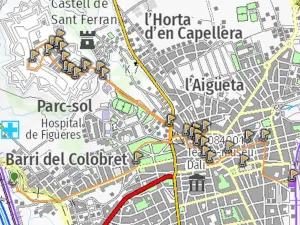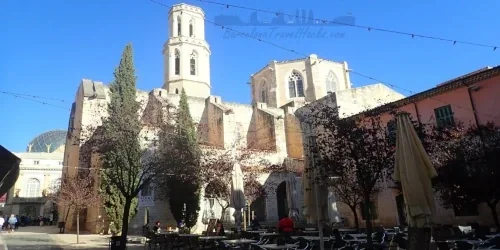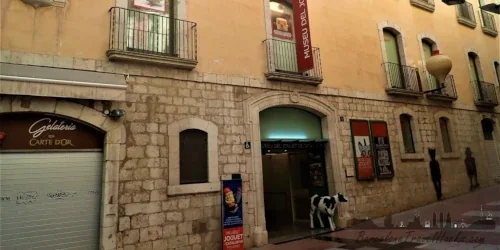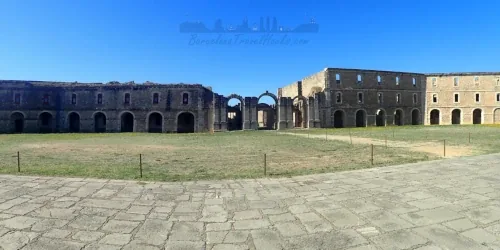
Dalí Theatre-Museum Figueres – Tickets, Hours & Surrealist Highlights
Visit the Dalí Theatre-Museum in Figueres. Tickets, hours, surrealist rooms, masterpieces, and travel tips from Barcelona to Catalonia’s must‑see site
About the Dalí Theatre-Museum in Figueres
Celebrated 20th‑century surrealist artist Salvador Dalí is the most famous citizen of Figueres, and it is here that visitors will find the Dalí Theatre-Museum (Teatre-Museu Dalí), the largest collection of his works anywhere in the world. This surrealist museum in Catalonia is an absolute must‑see for art enthusiasts and curious travellers alike, offering a bizarre and captivating series of rooms inside a converted theatre that Dalí himself curated and designed.
The Dalí Theatre-Museum Figueres is not only a gallery but also a surrealist architectural masterpiece. Dalí transformed the ruins of a municipal theatre destroyed during the Spanish Civil War into a living work of art. Every space inside reflects his eccentric vision, from the famous Rainy Cadillac installation in the courtyard to the Mae West Room, where furniture forms the portrait of the Hollywood actress when viewed from a special platform.
Dalí devoted his final years to this project, living inside the museum and shaping its distinct exhibition spaces. The building itself is considered a surrealist artwork, unusual in that the artist created and curated his own museum. Highlights include masterpieces such as Galatea of the Spheres, the melting clock paintings, and stereoscopic experiments that reveal Dalí’s fascination with science and optics.
The museum also holds deep personal significance: Salvador Dalí died in 1989 and is buried beneath the museum’s iconic glass dome, making Figueres not only his hometown but also his final resting place. This makes the Dalí Theatre-Museum one of the most unique cultural attractions in Spain, combining art, architecture, and biography in a single destination.
Dalí Theatre-Museum Exterior
The Dalí Theatre-Museum Figueres visit begins outside, where the entrance is not through the iconic red‑façaded building but via the restored theatre in Plaça Gala i Salvador Dalí. This square is the starting point for exploring the museum’s surrealist exterior architecture and public art installations.
In front of the theatre façade stands the ornate Memorial Monument to the Catalan philosopher Francesc Pujols, one of the first Dalí pieces visitors encounter. This monument sets the tone for the museum’s blend of art, philosophy, and eccentric design.
Continuing to the right of the façade, you will find three reproductions of a sculpture by Antoni Merci (1895) depicting the painter Meissonier (1815–1891), an artist admired by Dalí. These reproductions are mounted on columns formed from stacks of tractor wheel tires — a striking example of Dalí’s playful approach to public art and surrealist symbolism in the museum’s exterior spaces.
What's Inside the Dalí Theatre Museum in Figueres?
Dalí Theatre-Museum Courtyard
Entering the Dalí Theatre-Museum Figueres via the former theatre ticket hall, visitors are immediately transported into a surrealist realm filled with some of Salvador Dalí’s most iconic installations. The first space encountered is the open‑air courtyard, once the stalls area of the theatre, now dominated by the famous Rainy Cadillac installation (Cadillac plujós). This vintage car, surrounded by hanging sculptures, is one of the museum’s most photographed attractions. Don’t forget to peer inside the car windows and look up to take in the surrounding surrealist details.
Tip: Insert a 1€ coin into the meter and the Rainy Cadillac comes alive, a playful example of Dalí’s interactive art.
The courtyard is framed by narrow white corridors. The right corridor (facing the stage) displays works by Evarist Vallès and leads into the Dalí Crypt, the artist’s final resting place beneath the stage. This sequence — courtyard, Rainy Cadillac, and crypt — forms one of the most memorable parts of the Dalí Theatre-Museum Figueres visit, blending surrealist spectacle with personal legacy.
Dalí Theatre-Museum Fishmonger's Hall
Leaving the Dalí Crypt, visitors enter the Fishmonger's Hall (Sala de Peixateries), one of the museum’s most striking galleries. This space houses a remarkable collection of Dalí oils, including the famous Soft Self‑Portrait with Fried Bacon (Autoretrat Tou amb Tall de Bacon Fregit), a surreal depiction of the artist’s own face, and the Dalí Picasso portrait (Retrat de Picasso), which reflects Dalí’s complex relationship with fellow Spanish painter Pablo Picasso.
The hall is complemented by the left ground‑floor corridor, which contains graphic art by Salvador Dalí. Together, these works showcase Dalí’s versatility across mediums, from oil paintings to prints, and highlight the breadth of his creativity within the Dalí Theatre-Museum Figueres.
Dalí Theatre-Museum Stage
Proceeding up the stairs onto the stage, visitors are confronted by the monumental mural The Hallucinogenic Toreador, a vast surrealist composition that spans the full height of the stage wall. This masterpiece blends Dalí’s fascination with classical imagery, optical illusions, and his recurring motif of the bullfighter, making it one of the most recognisable highlights of the Dalí Theatre-Museum Figueres.
On the left side of the stage is another intriguing work: up close it appears as abstract cubist art with a central nude, but when viewed from a distance it transforms into the portrait of Abraham Lincoln. Dalí created this optical illusion after studying scientific publications on perception and optics, demonstrating his interest in merging art with science.
Tip: It is on the stage where you will find an unmarked stone slab marking Dalí’s burial site. Take a moment to look up from the tomb to the museum’s iconic glass dome, whose pattern resembles the compound eye of a fly — a perspective Dalí believed revealed new ways of seeing the world.
Dalí Theatre-Museum Treasure Room
From the stage, visitors enter the Treasure Room, a striking red‑walled gallery that contains many of Salvador Dalí’s masterpieces. This space highlights the breadth of Dalí’s creativity, from surrealist oils to stereoscopic experiments:
- Port Alguer: Depicts the port of Cadaqués, near Dalí’s summer house in Port Lligat, a recurring motif in his work.
- Leda Atòmica: A portrait of Gala inspired by the myth of Leda and the swan, blending classical mythology with Dalí’s surrealist vision.
- The Spectre of Sex Appeal: Shows Dalí as a child confronting a monstrous figure, symbolising sexuality, framed by the hyper‑realist landscape of Cap de Creus. The crutches in the composition represent death and resurrection, recurring symbols in Dalí’s art.
- Basket of Bread: Bread was one of Dalí’s oldest subjects of obsession, symbolising continuity and sacred subsistence.
- Galatea of the Spheres: A portrait of Gala Dalí composed of spheres, reflecting Dalí’s fascination with nuclear physics after the atomic bomb explosions of 1945.
- Dalí Seen from the Back Painting Gala from the Back Eternalized by Six Virtual Corneas Provisionally Reflected by Six Real Mirrors: A stereoscopic experiment from the 1970s, showcasing Dalí’s interest in optics and perception.
- The Swallow’s Tail: Dalí’s final oil painting, completed in 1983 at the Castle of Púbol, marking the culmination of his artistic career.
Dalí Theatre-Museum Mae West Room
From the stage, visitors can access the first‑floor corridors around the courtyard, which display Salvador Dalí paintings and pencil drawings. Off this corridor lies one of the museum’s most famous attractions: the Mae West Room. This surrealist installation contains a giant collage of the face of the American actress Mae West, ingeniously formed from components of a home interior. The most iconic element is the Dalí lips sofa, shaped like female lips, which serves as the centrepiece of the portrait.
This optical illusion room was designed by Dalí specifically for the museum, blending furniture, sculpture, and perspective into a single surrealist collage. Behind the Mae West installation is a wall with peep holes on either side, offering views into a surrealist bedroom space filled with hanging plants, giving the impression of a jungle interior.
Tip: Climb the steps to the viewing platform inside the Mae West Room to see the portrait correctly aligned. From this perspective, the sofa, fireplace, and curtains merge into the unmistakable face of Mae West — a perfect example of Dalí’s fascination with optical illusions and theatrical surrealism.
Dalí Theatre-Museum Masterpiece Room
Ascending the stairs to the second floor reveals a white, narrow horseshoe‑shaped corridor around the courtyard and stage, lined with works by Antoni Pitxot and preceded by a surrealist installation created by Salvador Dalí. This corridor sets the stage for the museum’s upper galleries.
Continuing upward to the third floor, visitors enter the Rue Trajan corridor, which contains additional Dalí works and leads directly into the Masterpiece Room. This gallery showcases part of Dalí’s private art collection, reflecting his admiration for other masters. Highlights include El Greco paintings, works by Marià Fortuny, Modest Urgell, Ernest Meissonier, and pieces by Marcel Duchamp and Gerard Dou. Among these treasures is Dalí’s own Impressions of Bouguereau, which demonstrates his ability to reinterpret classical styles through a surrealist lens.
The Masterpiece Room is a unique space within the Dalí Theatre-Museum Figueres, offering visitors a rare glimpse into Dalí’s eclectic tastes and the influences that shaped his artistic vision. It stands as a testament to his role not only as a creator but also as a collector and curator of art history.
Dalí Theatre-Museum Palace of the Wind
Descending to the second floor, visitors can explore the left side of the theatre, which includes Dalí’s private chambers where he lived and slept during the final years of his life. This intimate area is most renowned for the Palace of the Wind (El Palacio del Viento), a giant ceiling fresco depicting a surrealist human figure with dancing feet pointing toward the floor and the body gazing upward to the heavens. In Dalí’s bedroom, visitors will also find wall art featuring a Salvador Dalí melting clock, one of his most iconic motifs.
Also located on this floor is the Poetry of America Room, which contains the titular oil on canvas painting created by Dalí in Monterrey, California, in 1943. The composition blends landscapes of the Empordà plain, Cap de Creus, and the vast American deserts, symbolising Dalí’s dialogue between Catalonia and the United States.
At the end of the corridor is the Bramante’s Temple Room (Sala Templete de Bramante), which houses a surrealist installation by Dalí. Together, the Palace of the Wind fresco, Poetry of America painting, and Bramante’s Temple installation make this floor one of the most diverse and personal areas of the Dalí Theatre-Museum Figueres, combining private spaces with monumental works.
Dalí Theatre-Museum Loggia Rooms
The next stop on the route is the Loggia Room, which showcases Dalí’s creative dialogue with Diego Rodríguez de Silva y Velázquez (1599–1660). This gallery highlights Dalí’s admiration for Velázquez’s timeless art and his ability to reinterpret classical influences through a surrealist lens.
From here, visitors continue into The Tower of All the Enigmas Room, which contains the titular oil on copper piece painted by Dalí for the cover of Vogue magazine in 1971. This work exemplifies Dalí’s fascination with mystery, symbolism, and the blending of fine art with popular culture.
It is from this space that visitors can access the Dalí Theatre-Museum terrace garden, a quiet spot to pause and reflect before exiting. After the garden, the route leads to the museum gift shop. Just before the exit turnstiles, a staircase on the right ascends to the Dalí Jewels Collection, an exquisite exhibition of gold and gemstone designs created by Dalí, which should not be missed.
Dalí Theatre-Museum Jewels Collection
Tip: Do not go through the exit turnstile without first visiting the Jewels Collection.
The Dalí Theatre-Museum Figueres ticket includes access to the Dalí Jewels Collection, a separate exhibition space that showcases an exquisite blend of creativity and craftsmanship. The collection features 39 gold jewels and precious stones from the Owen Cheatham collection, all based on original design drawings by Salvador Dalí. Each jewellery item is accompanied by Dalí’s design sketch, highlighting the artist’s meticulous attention to detail.
Among the highlights are the Dalí d’Or Jewels, a dazzling series of gold creations designed by Dalí in the 1940s and later remodelled for display. These pieces demonstrate Dalí’s ability to merge surrealist imagination with fine jewellery design, elevating everyday objects into works of art.
Notable items include a lobster brooch with a pearl in its claw, a pair of earrings featuring Gala’s portrait, and a necklace with a melting clock pendant — echoing Dalí’s most iconic motif. In addition to these, the Salvador Dalí Jewels Collection also contains jewellery boxes, watches, and other accessories, making this exhibition one of the most unique and unexpected parts of the museum visit.
Dalí Theatre-Museum History
The origins of the Dalí Theatre-Museum Figueres date back to the 1960s, when the mayor of Figueres asked Salvador Dalí to donate a single piece to the local Museum of Empordà. Dalí responded in typically grand fashion: instead of one artwork, he proposed creating an entire museum dedicated to his vision.
The chosen site was the former municipal theatre of Figueres, which had been reduced to ruins by a fire at the end of the Spanish Civil War. Only the outer stone walls, the stalls, and the arch over the stage mouth remained intact, while the orchestra pit and much of the interior had collapsed. Dalí saw this semi‑destroyed shell as the perfect canvas for his surrealist project.
Throughout the 1970s, Dalí devoted his full attention to transforming the theatre into a museum. He lived inside the building while overseeing its reconstruction, shaping the distinct exhibition rooms and ensuring that every detail reflected his eccentric imagination. The Dalí Theatre-Museum officially opened on 28 September 1974.
Unlike most museums, this space was conceived and curated entirely by the artist himself. With the exception of a few works by painters Dalí admired, every gallery and installation was designed to be part of a larger surrealist artwork. Today, the museum houses the largest collection of Dalí’s works, making it both a gallery and a monumental self‑portrait of the artist.
Salvador Dalí died on 23 January 1989 and, in accordance with his wishes, was buried inside the museum beneath its iconic glass dome. Unusually, he is not entombed with his beloved wife Gala Dalí, who rests at Púbol Castle. This makes the Dalí Theatre-Museum not only a cultural landmark but also the artist’s final resting place.
Dalí and Drugs
Salvador Dalí is often associated with psychedelic imagery, leading to speculation about drug use, i.e. LSD. However, Dalí himself famously declared: “I don’t do drugs. I am drugs.” He avoided narcotics and hallucinogens, insisting that his mind alone was the source of his surreal visions.
Instead of relying on substances, Dalí developed unique methods to stimulate creativity. His paranoiac‑critical method involved deliberately inducing irrational associations and dreamlike imagery, which he then translated into paintings. This technique allowed him to access subconscious ideas while remaining fully in control of his craft.
Dalí also practiced what he called the “slumber with a key” technique. He would sit in a chair holding a spoon over a plate, drifting into sleep. As he nodded off, the spoon would fall and wake him instantly, enabling him to capture the fleeting images from his micro‑dream state. These visions often became the basis for his surrealist works.
Through these methods, Dalí achieved the hallucinatory quality of his art without drugs. Works such as the Hallucinogenic Toreador showcase his ability to channel subconscious imagery, while optical experiments like the Abraham Lincoln portrait illusion demonstrate his fascination with science and perception. Together, they reveal how Dalí harnessed psychology, sleep, and imagination to create effects that rivalled psychedelic experiences, all while remaining substance‑free.
Image Gallery For The Dalí Theatre-Museum in Figueres
Click on any of the 17 images to open full screen gallery player. Note that viewing images is subject to our Fair Use Policy.
Visiting The Dalí Theatre-Museum in Figueres
The Dalí Theatre-Museum is one of the most popular attractions in Figueres, and tickets often sell out quickly. I strongly recommend booking Dalí Museum tickets in advance to secure your preferred time slot. Note: the early morning sessions are always the busiest. For a quieter experience, choose a visit between 13:00h and 16:00h, when many locals are at lunch and the museum is less crowded.
Note: At present, I cannot post interior photos of the Dalí Theatre-Museum Figueres as I am awaiting rights clearance from the Dalí Foundation. However, I can confirm that the Dalí Museum is a must‑visit attraction when travelling from Barcelona or Girona. Inside, you will find the famous Dalí melting clock painting alongside other surrealist masterpieces that define his legacy.
Allow at least two hours to explore the museum fully. Dalí Museum ticket prices start from 19 Euros, and I recommend adding the audio guide for insightful explanations of Dalí’s works, many of which defy simple description. Upon exiting, don’t miss the surrealist bookshop and gift store in Plaça Gala i Salvador Dalí, which sells items inspired by Dalí’s designs.
Dalí Theatre-Museum Figueres Opening Hours
- Tuesday to Sunday: 10:00 am to 6:00 pm
- Closed: Mondays (except certain public holidays)
Last admission is permitted up to 45 minutes before closing time. Visitors should plan accordingly to ensure enough time to explore the Dalí Theatre-Museum Figueres, which houses the largest collection of Salvador Dalí’s works. During peak seasons and holidays, opening hours may be extended, so it is advisable to check the official Dalí Museum schedule before visiting.
Accessibility & What to take to the Dalí Theatre-Museum in Figueres
For a Figueres day trip, I recommend packing light. A small 10L rucksack with a fleece jersey is ideal, and if rain is forecast, bring a waterproof poncho. This ensures comfort while exploring both the town and the Dalí Theatre-Museum.
The museum’s locker room is currently closed, and bag access is restricted to items under 35 × 35 × 25 cm. All bags must pass through an airport‑style security scanner. Larger items such as umbrellas, pushchairs, or other bulky objects must be left in the consignment office before entry.
Wear comfortable walking shoes, as the Dalí Theatre-Museum Figueres is located about one kilometre from the railway station. The walk is straightforward but can feel long if you’re carrying heavy bags or wearing unsuitable footwear.
The museum offers partial wheelchair access. Some areas are accessible, while others may present limitations due to the historic structure of the building. For detailed information, consult the official Dalí Museum accessibility guide on their website before your visit.
Tickets for The Dalí Theatre-Museum in Figueres
Getting to Figueres
Address: Plaça Gala i Salvador Dalí 5, Figueres, 17600
Figueres is well connected by train from Barcelona and Girona, making it an easy day trip. The town has two stations: the central Figueres station served by Regional trains, and the modern Figueres‑Vilafant AVE station on the outskirts, located about a 20‑minute walk from the town centre and close to the Dalí Theatre-Museum.
The Regional trains depart from Barcelona‑Sants, stopping at Barcelona‑Passeig de Gràcia, Girona, and other intermediate stations before reaching Figueres. There are two types of Regional service: the MD train, which makes fewer stops and offers more comfortable carriages with tables, arriving about 20 minutes faster; and the R11 train, which stops at every station along the route and takes approximately 1 hour 50 minutes.
The AVE high‑speed trains connect Barcelona‑Sants to Figueres‑Vilafant in just 50 minutes. From there, visitors can walk to the fortress or take local transport into the town centre.
For a train map comparing all routes from Barcelona or Girona to Figueres, see the documents section.
If travelling by car, convenient parking is available at Parking Saba El Garrigal, located directly behind the Dalí Theatre‑Museum in Carrer Canigó. From here, it is a short walk to both the museum and Sant Ferran Fortress, making it easy to combine visits.
Documents for the Dalí Theatre-Museum in Figueres
Wikiloc Trail for My Figueres Tourist Route

Please sign in with Google to view the Wikiloc Route map.
Sign in with GoogleWeather for Figueres
Accommodation in Figueres
Nearby Attractions to the Dalí Theatre-Museum in Figueres
 TRAIN
TRAIN
Figueres Sant Pere Church – Dalí Baptism, Funeral & Gothic Heritage
Visit Figueres Sant Pere Church, where Salvador Dalí was baptised and his funeral held. Gothic heritage, mass times, and tips near the Dalí Theatre-Museum
Read more >
 TRAIN
TRAIN
Figueres Toy Museum – Museu de Joguet de Catalunya
Discover 3 floors of historic toys at Figueres Toy Museum, from 1900s dolls to 1980s consoles, plus the famous Meccano Eiffel Tower
Read more >
 TRAIN
TRAIN